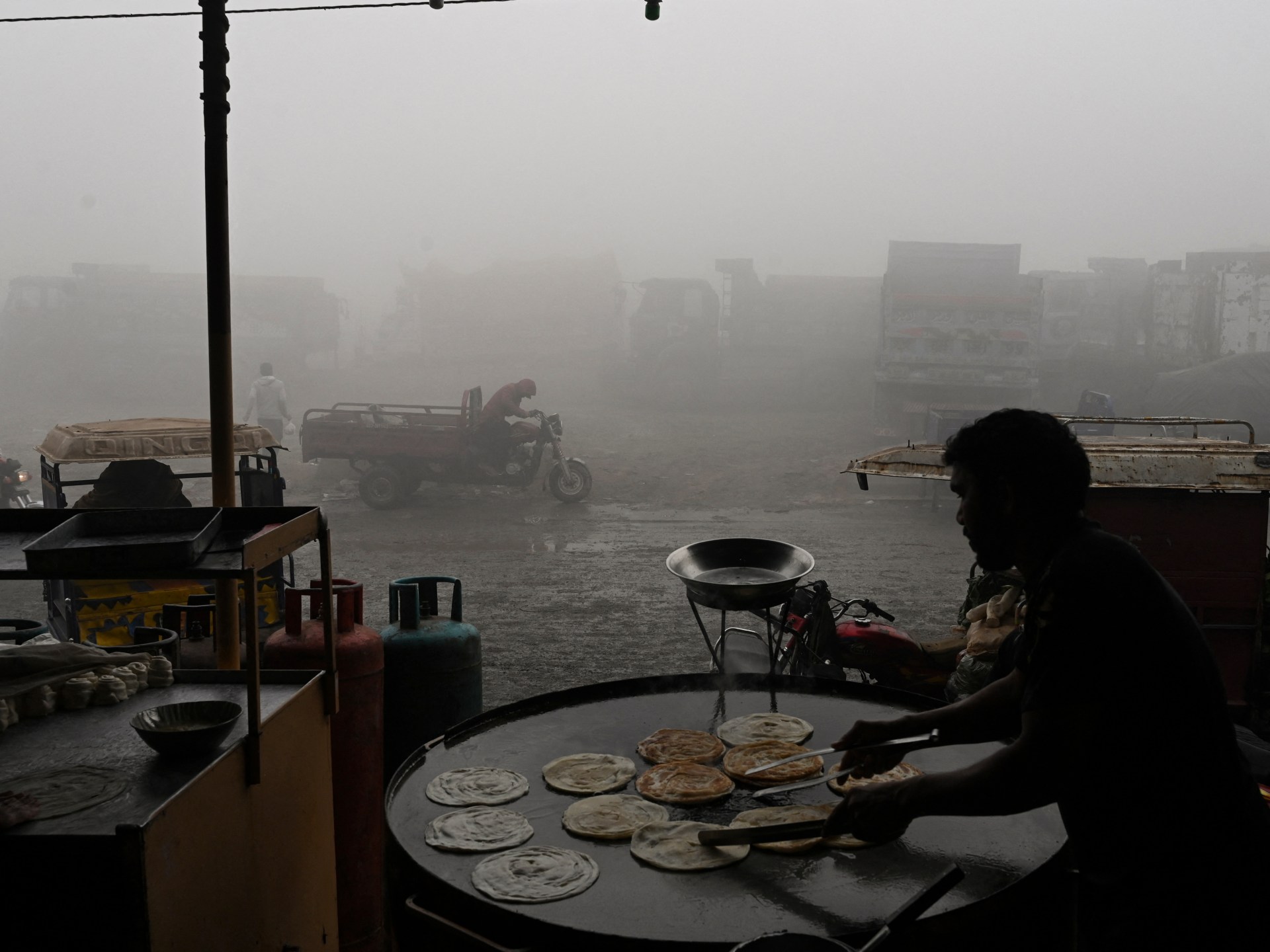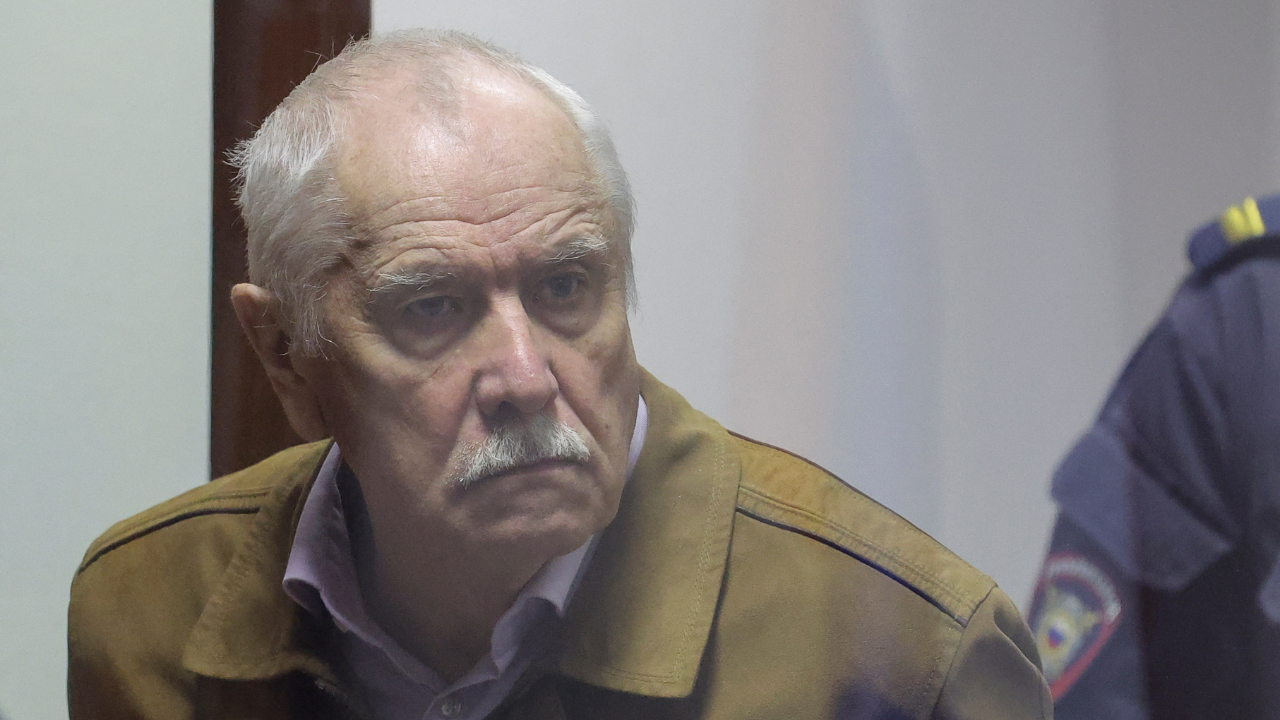World
Pakistan uses artificial rain for the first time to fight pollution

Cloud seeding was used to counter the hazardous smog in the megacity of Lahore, one of the world’s most polluted cities.
Artificial rain has been used for the first time in Pakistan in a bid to combat hazardous levels of pollution in the megacity of Lahore, says the provincial government.
Planes equipped with cloud-seeding equipment flew on Saturday over the eastern city, often ranked one of the worst places globally for air pollution.
“It drizzled in at least 10 areas of Lahore,” caretaker chief minister of Punjab, Mohsin Naqvi, told reporters, adding that the authorities were monitoring the impact of artificial rain in a radius of 15km (nine miles).
Air quality in Lahore has been particularly bad in the last few weeks and the Punjab government employed several tactics including the early closure of businesses and keeping schools off for two extra days to help improve the air quality – but nothing worked.
The “gift” was provided by the United Arab Emirates, Naqvi said.
“Teams from the UAE, along with two planes, arrived here about 10 to 12 days ago. They used 48 flares to create the rain,” he said.
Naqvi said the team would be able to assess the effects of the experiment by Saturday night.
The UAE has increasingly used cloud seeding, sometimes referred to as artificial rain or blueskying, to create rain in the arid expanse of the country.
In the cloud-seeding process, silver iodide, a yellowish salt, is burned in clouds in a compound with acetone to encourage condensation to form as rain.
Naqvi reassured the public of the safety of the artificial rain, citing more than 1,000 annual missions by the UAE and similar technologies used in dozens of countries, including the United States, China and India.
Lahore’s toxic smog
Even very modest rain is effective in bringing down pollution, experts have said.
Levels of PM2.5 pollutants – cancer-causing microparticles that enter the bloodstream through the lungs – were measured as hazardous in Lahore on Saturday at more than 66 times the World Health Organization’s danger limits.
Air pollution has worsened in Pakistan in recent years, as a mixture of low-grade diesel fumes, smoke from seasonal crop burn off and colder winter temperatures coalesce into stagnant clouds of smog.
Lahore has suffered the most from the toxic smog, choking the lungs of more than 11 million residents in Lahore during the winter season.
Breathing the poisonous air has catastrophic health consequences.
Prolonged exposure can trigger strokes, heart disease, lung cancer and respiratory diseases, according to the WHO.
The Pakistani authorities blame industrial emissions, smoke from brick kilns and vehicles, and the burning of crop residue and general waste for causing air pollution and smog in the central Punjab province.
Naqvi said that there would be more instances of artificial rain in the city, in which smog towers – large-scale air purifiers designed to capture pollution – would also be installed in the coming weeks.
Growing industrialisation in South Asia in recent decades has driven an increase in pollutants emanating from factories, construction activity and vehicles in densely populated areas.
The problem becomes more severe in cooler autumn and winter months, as temperature inversion prevents a layer of warm air from rising and traps pollutants closer to the ground.
Rising air pollution can cut life expectancy by more than five years per person in South Asia, one of the world’s most polluted regions, according to a report published in August which flagged the growing burden of hazardous air on health.
Pakistan is responsible for less than 1 percent of global carbon emissions but is among the top 10 most climate-vulnerable nations.

World
Primo Cancelled at Freevee After ‘Short but Beautiful Run,’ Says Creator

ad
World
Russian physicist accused of treason sentenced to 14 years in prison

- Anatoly Maslov, a Russian physicist, has been sentenced to 14 years in prison for his alleged involvement in researching super-high flight speeds.
- This is the most recent in a series of treason cases that Russia has pursued against scientists researching super-high flight speeds.
- Maslov was a top scientist at the Khristianovich Institute of Theoretical and Applied Mechanics in the Siberian city of Novosibirsk.
Russia has brought a string of treason cases against scientists researching super-high flight speeds, an area that underpins its development of hypersonic missiles.
In the latest, physicist Anatoly Maslov was sentenced to 14 years on Tuesday.
President Vladimir Putin has boasted of Russia’s prowess in hypersonic missiles and Moscow has acknowledged using them in the Ukraine war.
RUSSIA’S MILITARY CLAIMS TO HAVE SHOT DOWN 10 U.S.-SUPPLIED MISSILES OVER CRIMEA AS BLINKEN VISITS UKRAINE
Here is a summary of the cases it has launched against scientists working in this sensitive field.
Russian physicist Anatoly Maslov, who was arrested in 2022 and accused of state treason, stands behind a glass wall of an enclosure for defendants before a court hearing in Saint Petersburg, Russia, on May 21, 2024. (REUTERS/Anton Vaganov)
ANATOLY MASLOV, ALEXANDER SHIPLYUK AND VALERY ZVEGINTSEV
All three were top scientists at the Khristianovich Institute of Theoretical and Applied Mechanics (ITAM) in the Siberian city of Novosibirsk. Maslov and Shiplyuk were arrested in 2022, and Zvegintsev the following year. In a rare open letter a year ago, colleagues said the three men were innocent and the cases against them were damaging Russian science. Details of the charges are secret, but two people familiar with Shiplyuk’s case have told Reuters he is accused of betraying secrets to China by handing over classified material at a conference there in 2017.
VLADISLAV GALKIN
Galkin worked at another Siberian university and had co-authored papers with Zvegintsev and Shiplyuk. His arrest was reported in December 2023, but BBC Russian said he was actually detained in April of that year. It quoted his wife as saying she had told their grandchildren he was on a business trip.
ALEXANDER KURANOV
Kuranov was handed a seven-year jail sentence for treason last month, after being accused of passing state secrets to foreign nationals. Maslov’s lawyer, without naming Kuranov, said the case against Maslov had been based on testimony against him from another person who got a seven-year term. At the time of his arrest in 2021, Kuranov was the general director of the St Petersburg-based Hypersonic Systems Research Facility, where he oversaw work on a new version of a Soviet-era hypersonic aircraft dubbed Ayaks.
ANATOLY GUBANOV AND VALERY GOLUBKIN
Both worked at TsAGI, the Central Aerohydrodynamic Institute based in Zhukovsky, near Moscow, where Gubanov was Golubkin’s boss.
Gubanov, arrested in December 2020, had been working on an international project called HEXAFLY-INT to develop a hypersonic civil aircraft powered by hydrogen fuel. In October 2023 he was found guilty of handing over state secrets and sentenced to 12 years.
Golubkin, arrested in April 2021, was jailed for 12 years in June 2023 after being found guilty of passing secrets to a NATO member state. However, the verdict was annulled last month and a new trial ordered.
VIKTOR KUDRYAVTSEV, ROMAN KOVALYOV AND VLADIMIR LAPYGIN
All three worked at TsNIIMash, a rocket and spacecraft center near Moscow which is a scientific subsidiary of space agency Roscosmos. Kudryavtsev was arrested on a treason charge in 2018, suspected of transferring secret information to a Belgian institute. He died of lung cancer in 2021, before the case came to trial.
Kovalyov, who worked with Kudryavtsev at TsNIIMash, was sentenced to seven years for treason in June 2020. He died of cancer in 2022.
Lapygin was convicted of treason in 2016 and sentenced to seven years, but was freed early in 2020.
World
Who is Ali Bagheri Kani, Iran’s acting foreign minister?

Ali Bagheri Kani, a 57-year-old political insider with a history of serving in Iran’s diplomatic and security apparatuses, has been appointed interim foreign minister following the death of the man he is replacing, Hossein Amirabdollahian.
Amirabdollahian died on Sunday in a helicopter crash in Iran’s mountainous East Azerbaijan province, alongside President Ebrahim Raisi and several other officials and staff.
Bagheri Kani is the logical choice to come in as acting foreign minister – he had been Amirabdollahian’s deputy for political affairs.
The new foreign minister was born in a village just north of the capital Tehran to a conservative family that helped establish and strengthen Iran.
Family members have had prominent roles in the country. His father, the now 98-year-old prominent cleric Mohammad-Bagher Bagheri Kani, is a former member of parliament and the Assembly of Experts, the clerical body tasked with appointing a successor to the 85-year-old Supreme Leader Ayatollah Ali Khamenei.
And his uncle, Mohammad Reza Mahdavi Kani, was a former acting prime minister and interior minister, who led the Assembly of Experts from 2010 until his death in 2014. The new acting foreign minister’s brother, Mesbah al-Hoda Bagheri Kani, is a son-in-law of Supreme Leader Ayatollah Ali Khamenei.
Bagheri Kani studied economics at Tehran’s Imam Sadiq University, a school that has produced many members of Iran’s government, and which used to be run by his father.
Close ally of Jalili
He started his diplomatic career at a regional desk of the Iranian Ministry of Foreign Affairs, and also did a brief stint as political analyst at state television.
He has been a longtime close associate of Saeed Jalili, a key ultraconservative figure within the establishment who now holds a senior position on Iran’s Supreme National Security Council (SNSC).
Like Jalili, Bagheri Kani’s name is mostly associated with the years-long talks surrounding Iran’s nuclear programme, and he served as Jalili’s deputy on the SNSC shortly after the latter was appointed secretary of the body in 2007, at a time of heightened tensions over the nuclear issue.
As the SNSC was at the time in charge of handling the nuclear file, Bagheri Kani also became a senior figure in the country’s negotiating team and held meetings with US and European officials.
Those negotiations ultimately fell through, and Iran was slapped with a series of harsh international sanctions.
Jalili eventually went on to run for president in 2013, wishing to put forward his pessimistic view towards any nuclear deal with the West. Bagheri Kani managed his election campaign, which failed.
The victory that year of the centrist Hassan Rouhani, who promised the lifting of sanctions and an end to Iran’s isolation, led Jalili and Bagheri Kani to become relatively sidelined.
Rouhani’s administration was able to agree on a nuclear deal, known formally as the Joint Comprehensive Plan of Action (JCPOA) with Western countries in 2015, but it did not last long, as US President Donald Trump withdrew from it unilaterally in 2018, and imposed even harder sanctions on Iran.
Aligned with Raisi
In 2019, Raisi, who ran for president in 2017 in an unsuccessful attempt to prevent Rouhani’s re-election, was appointed as the judiciary chief by Khamenei. It came as sanctions were taking their toll on the economy, and weakening the power of reformists and centrists.
Raisi brought Bagheri Kani into his team, appointing him as the head of international affairs of the judiciary. Bagheri Kani was also made the head of the human rights council of the judiciary, replacing Mohammad Javad Larijani, who had held the position for 14 years.
By the time President Joe Biden’s administration was in power in the US and Raisi had eventually won the Iranian presidency at the second attempt in 2021, efforts were under way to restore the JCPOA to reduce tensions.
Just before European-mediated talks with the US were slated to begin in late 2021, Bagheri Kani was appointed as chief negotiator, replacing veteran diplomat Abbas Araghchi, who had been instrumental in negotiating the nuclear deal.
The JCPOA continues to be in limbo, and Iran has now achieved the status of a threshold nuclear state, but talks are continuing with the International Atomic Energy Agency (IAEA), which Bagheri Kani will have to handle in cooperation with Iran’s nuclear agency.
Tehran has also kept lines of communication open with Europe, along with Washington, with mediated talks taking place in Oman this month. More negotiations aimed at reducing tensions amid Israel’s war on Gaza are expected soon, which would be overseen by the caretaker foreign minister.
Amirabdollahian, the late foreign minister, was active in representing Iran’s interests and alliances across the region during the war, taking tours to meet with top officials in Syria, Lebanon, Qatar and elsewhere.
Bagheri Kani is expected to carry on the torch, emphasising Tehran’s call for a ceasefire in Gaza and opposing Western presence and influence in the region, while backing its own allies.
-

 News1 week ago
News1 week agoSkeletal remains found almost 40 years ago identified as woman who disappeared in 1968
-

 World1 week ago
World1 week agoIndia Lok Sabha election 2024 Phase 4: Who votes and what’s at stake?
-

 World1 week ago
World1 week agoUkraine’s military chief admits ‘difficult situation’ in Kharkiv region
-

 Movie Reviews1 week ago
Movie Reviews1 week agoAavesham Movie Review
-

 World1 week ago
World1 week agoCatalans vote in crucial regional election for the separatist movement
-

 News1 week ago
News1 week agoTrump, Reciting Songs And Praising Cannibals, Draws Yawns And Raises Eyebrows
-

 Movie Reviews1 week ago
Movie Reviews1 week agoUnfrosted Movie Review: A sweet origins film which borders on the saccharine
-

 Politics1 week ago
Politics1 week agoNorth Dakota gov, former presidential candidate Doug Burgum front and center at Trump New Jersey rally


















